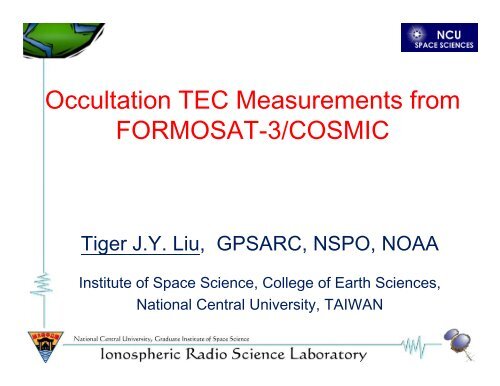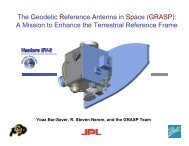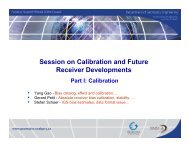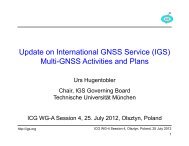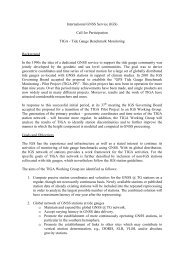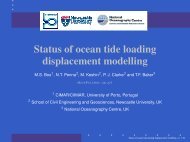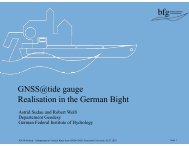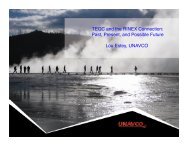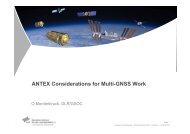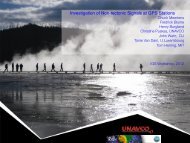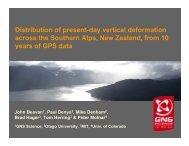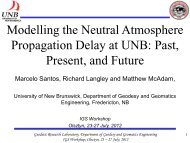Occultation TEC Measurements from FORMOSAT-3/COSMIC - IGS
Occultation TEC Measurements from FORMOSAT-3/COSMIC - IGS
Occultation TEC Measurements from FORMOSAT-3/COSMIC - IGS
Create successful ePaper yourself
Turn your PDF publications into a flip-book with our unique Google optimized e-Paper software.
<strong>Occultation</strong> <strong>TEC</strong> <strong>Measurements</strong> <strong>from</strong><br />
<strong>FORMOSAT</strong>-3/<strong>COSMIC</strong><br />
Tiger J.Y. Liu, GPSARC, NSPO, NOAA<br />
Institute of Space Science, College of Earth Sciences,<br />
National Central University, TAIWAN
Outline<br />
<strong>FORMOSAT</strong>-3/<strong>COSMIC</strong><br />
Tropospheric Observation<br />
Ionospheric Observation<br />
Seismo-ionospheric Study<br />
FOEMOSAT-7/<strong>COSMIC</strong>-2<br />
Summary<br />
2<br />
21-Jul-10
Solar Terrestrial Environment
Thermosphere<br />
Plasmasphere<br />
(Protonsphere)<br />
Ionosphere<br />
Mesosphere<br />
Stratosphere<br />
Neutral Atmosphere<br />
Troposphere
<strong>TEC</strong>u<br />
120<br />
Ionospheric total electron content<br />
(<strong>TEC</strong>) derived <strong>from</strong> GPS<br />
Receiver: YMSM (North Taiwan)<br />
L1:1575.42 MHz (10.23 MHz×154 )<br />
L2:1227.60 MHz (10.23 MHz×120)<br />
C/A code (1.023 MHz)<br />
P code (10.23 MHz)<br />
90<br />
60<br />
30<br />
0<br />
08:00 14:00 20:00 02:00 08:00<br />
(x i , y i , z i ) Local Time<br />
<strong>TEC</strong> (total electron content)<br />
unit: <strong>TEC</strong>u (10 16 ele/m 2 )<br />
ionosphere<br />
S o =[(x i -x j ) 2 +(y i -y j ) 2 +(z i -z j ) 2 ] 1/2<br />
Line-of-sight<br />
(x j ,y j , z j )<br />
6
<strong>FORMOSAT</strong>-3/<strong>COSMIC</strong><br />
Space-based GPS receiver
<strong>FORMOSAT</strong>-3/<strong>COSMIC</strong><br />
Global Real-time<br />
Weather (Meteorology)<br />
Space Weather (Ionosphere)<br />
Observation and Prediction<br />
The <strong>FORMOSAT</strong>-3/<strong>COSMIC</strong> program is an international<br />
collaboration between Taiwan and the United States that<br />
will use a constellation of six remote sensing microsatellites<br />
to collect atmospheric data for weather prediction and for<br />
ionosphere, climate and gravity research. Data <strong>from</strong> the<br />
satellites will be made freely available to the international scientific<br />
community in near real-time.
<strong>FORMOSAT</strong>-3/<strong>COSMIC</strong><br />
• <strong>FORMOSAT</strong>-3/<strong>COSMIC</strong><br />
Constellation was launch at<br />
01:40 UTC, April 14, 2006<br />
(Taiwan Time: April 15 2006) at<br />
Vandenberg Air Force Base,<br />
CA. Minotaur Launch<br />
• Maneuvered into six different<br />
orbital planes (inclination ~72°)<br />
for optimal global coverage (at<br />
~800 km altitude).<br />
• All satellites are in good<br />
health and providing science<br />
data.
<strong>FORMOSAT</strong>-3/<strong>COSMIC</strong><br />
The <strong>FORMOSAT</strong>-3/<strong>COSMIC</strong> system is a<br />
constellation of 6 LEO micro-satellites<br />
Each satellite carries 3 payloads:<br />
– GPS occultation ti receiver<br />
– Tiny Ionospheric<br />
Photometer<br />
– Tri-Band Beacon.<br />
Global observation of pressure,<br />
temperature, water vapor,<br />
refractivity, ionospheric<br />
electron density and<br />
scintillation for weather and space weather<br />
research as well as climate monitoring<br />
Demonstrate quasi-operational GPS limb<br />
sounding with global coverage in near-real<br />
time
Global<br />
Positioning<br />
i<br />
System
Gps <strong>Occultation</strong> eXperiment (GOX)
<strong>FORMOSAT</strong>-3/<strong>COSMIC</strong><br />
Profiling the Troposphere, Stratosphere and Ionosphere by Radio <strong>Occultation</strong>
Mission Orbit of <strong>FORMOSAT</strong>-3/<strong>COSMIC</strong>
<strong>FORMOSAT</strong>3/<strong>COSMIC</strong><br />
-Troposphere<br />
p<br />
Walker Circulation: La Niña, El Niño<br />
Hadley Circulation: Plateau Heating<br />
Polar Circulation: Planetary Wave
Distribution of occultation events observed<br />
by <strong>FORMOSAT</strong>-3<br />
More than 2500 radio occultation (RO) soundings (green dots)<br />
obtained by the GPS <strong>Occultation</strong> Experiment (GOX) each day. In<br />
comparison, radiosondes d (red dots) provide only approximately 1500<br />
soundings per day.
Super Typhoon Jangmi (2008)
<strong>COSMIC</strong> Profile Availability<br />
22.5-1.5 1.5-4.5 4.5-7.5 7.5-10.5<br />
10.5-13.5 13.5-16.5 16.5-19.5 19.5-22.5<br />
22.5-1.5(+1d)<br />
00 00z 00z<br />
DA time window<br />
Free forecast<br />
NCEP GFS for IC and LBC<br />
Availale conventional data<br />
<strong>COSMIC</strong> data is available continuously<br />
Not like radiosonde data available only at 00 and 12Z<br />
Not like radiosonde data available only at 00 and 12Z<br />
Cycling 3DVAR for long data assimilation time window<br />
is one of the optimal assimilation scheme
Cold 3DVAR vs Cycling 3DVAR<br />
Cold 3DVAR<br />
Cycling 3DVAR<br />
Significant improvement for trackforecast in cycling<br />
3DVAR
El Niño La Niña<br />
Walker Circulation
La Niña<br />
El Niño<br />
[Webster and Chang, J. Atmos. Sci., 1988]
Global F3/C tropopause height<br />
ENSO Warm<br />
ENSO Cold<br />
Normal<br />
ENSO Warm
(b)<br />
Tropospheric Pressure<br />
ENSO Warm<br />
ENSO Cold<br />
Normal<br />
ENSO Warm<br />
21-Jul-10<br />
23
Tropospheric Temperature<br />
ENSO Warm<br />
ENSO Cold<br />
Normal<br />
ENSO Warm
Tropospheric Water Vapor<br />
ENSO Warm<br />
ENSO Cold<br />
Normal<br />
ENSO Warm
Tibetan Plateau Heating<br />
Hadley Circulation and<br />
the reserved
Global Tropopause Height in July 2008
Global Tropopause Height in July 2009
Polar Cell Circulation<br />
Planetary Wave
The planetary wave signature
<strong>FORMOSAT</strong>3/<strong>COSMIC</strong><br />
-Ionosphere
Distribution of occultation events<br />
observed by <strong>FORMOSAT</strong>-3<br />
GOX
Ionosphere<br />
EIA and Plasma Cave<br />
Plasma Depletion Bay<br />
Pre-earthquake Anomaly
Equatorial plasma fountain<br />
Altitude (km)<br />
Low-Latitude Ionosphere is dominated by the<br />
electrodynamics<br />
1000<br />
900<br />
800<br />
Plasma<br />
fountain<br />
magnetic<br />
field line<br />
700<br />
600<br />
500<br />
400<br />
300<br />
200<br />
<br />
1600 LT<br />
<br />
Ratcliffe [1972]<br />
LT 10:00<br />
1000<br />
800<br />
600<br />
400<br />
200<br />
−20 0 20 40<br />
LT 13:00<br />
1000<br />
800<br />
600<br />
400<br />
200<br />
−20 0 20 40<br />
LT 16:00<br />
1000<br />
100<br />
−10 0 10 20 30 40<br />
Geographic Latitude<br />
A model simulated plasma fountain effect<br />
starting ti in the morning and enhance to its<br />
maximum around noon<br />
800<br />
600<br />
400<br />
200<br />
−20 0 20 40
Altitde [km]<br />
500<br />
400<br />
0100<br />
300<br />
200<br />
100<br />
Equatorial Ionization Anomaly<br />
0700 1000 1500<br />
[e]/cm 3 x 10 5<br />
10<br />
0300 0730 1030 1600 8<br />
9<br />
7<br />
0500 0800 1100 1700<br />
6<br />
0530 0830 1200 1900<br />
5<br />
4<br />
0600 0900 1300 2100 3<br />
2<br />
0630 0930 1400 2300<br />
1<br />
−45 −30 −15 0 15 30 45<br />
Geomagnetic latitude [ o N]<br />
Lin et al.[GRL 2008]<br />
July-August 2006<br />
0
2007 M-month
2007 J-month
2007 S-month
Ionospheric plasma cave/tunnel<br />
(a)<br />
(b)<br />
Plasma cave<br />
Plasma Tunnel<br />
Liu et al. (JGR, 2010)
Plasma Depletion Bay
Plasma Depletion Bay observed by F3/C and TIMED GUVI<br />
Nighttime ionospheric structures, 23:00 LT (global fixed local time)<br />
1.5<br />
1.0<br />
0.5<br />
0<br />
Geo eographic Latitud ude ( ° N)<br />
50<br />
40<br />
30<br />
20<br />
10<br />
0<br />
−10<br />
−20<br />
−30<br />
−40<br />
TIMED−GUVI 135.6nm PLOT YEAR=2006; DOY=141−153; TIME=20−22LT<br />
−50<br />
−180 −150 −120 −90 −60 −30 0 30 60 90 120 150 180<br />
Geographic Longitude ( ° E)<br />
Rayleights<br />
8<br />
6<br />
4<br />
2<br />
0
Plasma depletion bay<br />
Nighttime ionospheric structures: 3‐D images
Mid-latitude trough
Result and Interpretation<br />
<strong>FORMOSAT</strong>/<strong>COSMIC</strong> NmF2, M-month, 20:00MLT<br />
Pole edge<br />
EIA peak<br />
Pole edge<br />
Trough<br />
Trough<br />
Equator edge
<strong>FORMOSAT</strong>-3/<strong>COSMIC</strong> NmF2 Persudo-3D structure<br />
Northern Hemisphere, M-month<br />
lat ×alt ×time: 2°×2km ×0.5hr<br />
21-Jul-10<br />
49
Seasonal Variation<br />
Northern hemisphere<br />
Southern hemisphere<br />
50<br />
21-Jul-10
21-Jul-10<br />
51
21-Jul-10<br />
52
Seismo-ionospheric Precursor of<br />
the 12 May 2008 M7.9 Wenchuan<br />
Earthquake
China Earthquakes<br />
1998/05/01~2008/05/12 36 M 6.0 earthquakes<br />
2008/5/12 M7.9 Wenchuan Earthquake
Locations of the 35M6.0 earthquakes together with Wenchuan earthquake<br />
occurred in China during May 1, 1998-May 12, 2008.
A time series of GPS <strong>TEC</strong> right above the epicenter of the M7.9<br />
Wenchuan earthquake on May 15, 2008.
The GIMs observed at 08:00UT and global fixed 15:00 LT on day 6 before<br />
the 2008 Mw7.9 Sichuan Earthquake.<br />
0800UT<br />
1500LT<br />
R =10 043M 0.43M
D-6, 5/6 2008<br />
0600UT, 1300LT<br />
D-5, 5/7 2008<br />
0600UT, 1300LT<br />
D-4, 5/8 2008<br />
0600UT, 1300LT<br />
D-3, 5/9 2008<br />
1400UT, 2100LT<br />
D 2 5/10 2008<br />
D-2, 5/10 2008<br />
0400UT, 1100LT
Liu et al.[JGR, 2009]
Conclusion<br />
F3/C constantly observes the temperature,<br />
pressure, water vapor in the troposphere,<br />
which is essential for weather forecast and<br />
climate study.<br />
F3/C probes 3-D structures and dynamics of<br />
the ionospheric electron density and can be<br />
applied on space weather monitoring.<br />
F3/C+GIM should be useful to explore<br />
seismo-ionospheric anomalies of the GPS<br />
<strong>TEC</strong> before large earthquakes.
Ground- and Space-Based<br />
GPS Observations<br />
IRI assimilation<br />
GIM + F3/C <strong>TEC</strong>
GIM <strong>TEC</strong> vs. GIM+F3/C <strong>TEC</strong><br />
Latitude (°N)<br />
Longitude (°E)
<strong>FORMOSAT</strong>-7/<strong>COSMIC</strong>-2<br />
12 satellites<br />
Tri-G<br />
2014, 2017
<strong>FORMOSAT</strong>/<strong>COSMIC</strong>-Follow On<br />
Builds on the weather forecasting and<br />
ionospheric science success of<br />
<strong>FORMOSAT</strong>-3/<strong>COSMIC</strong><br />
Taiwan/NSPO and US/NOAA<br />
12 satellites + TriG receiver<br />
First launch 2014, second launch ~2017<br />
Improved performance<br />
5x+ increase in number of measurements<br />
Higher precision in the atmosphere/ionosphere<br />
C/NOFS Science Workshop 68<br />
May 20, 2010
<strong>FORMOSAT</strong>-7/<strong>COSMIC</strong>-2 v.s. . <strong>FORMOSAT</strong>-3/<strong>COSMIC</strong><br />
Mission<br />
Spacecraft<br />
<strong>FORMOSAT</strong>-7/<strong>COSMIC</strong>-2<br />
Establish an operational<br />
mission for near real-time<br />
numerical weather prediction<br />
8,000 (threshold) profiles per<br />
day (the objective number is<br />
10,000)<br />
NSPO design, procure, and<br />
integrate t 12 SCs<br />
NSPO will integrate new GNSS<br />
PL provided by JPL and perform<br />
12 SCs Integration and Test at<br />
NSPO<br />
<strong>FORMOSAT</strong>-3/<strong>COSMIC</strong><br />
Demonstration of near real-time<br />
numerical weather prediction<br />
1,600~1,800 profiles per day<br />
NSPO define system<br />
requirement<br />
NSPO and Orbital design SC ;<br />
UCAR provide PL suite<br />
EDU and FM1 I&T at Orbital<br />
FM2 to FM6 integration and test<br />
at NSPO<br />
Mission GPS/GALILEO/GLONASS GPS tracking capability<br />
Payload tracking capabilities
<strong>FORMOSAT</strong>-7/<strong>COSMIC</strong>-2 v.s. . <strong>FORMOSAT</strong>-3/<strong>COSMIC</strong><br />
Launch<br />
Vehicle<br />
Ground<br />
Operations<br />
Data<br />
Processing<br />
<strong>FORMOSAT</strong>-7/<strong>COSMIC</strong>-2<br />
NOAA will provide 2 (TBR)<br />
launches into selected<br />
orbits/inclinations<br />
NOAA’s responsibility to seek<br />
the ground Networks<br />
High degree of automated<br />
ground system for 12-satellite<br />
constellation<br />
Taiwan Data Processing<br />
Center<br />
US Data Processing Center<br />
<strong>FORMOSAT</strong>-3/<strong>COSMIC</strong> Mission<br />
Use MINOTAUR LV of the US Air<br />
Force via UCAR’s help<br />
Use USN ground stations for the<br />
first 2 years, and then supported<br />
by NOAA ground stations after 2<br />
years<br />
6-satellite constellation operations<br />
TACC and CDAAC
Social Impacts<br />
Explore Space<br />
Weather Sciences<br />
Enhance the Capabilities of<br />
Regional and Global<br />
Weather Prediction<br />
Monitor Climate Trend<br />
Enhance the Capability<br />
Enhance the Capability<br />
on Severe Weather<br />
Prediction
Mission Architecture<br />
GALILEO<br />
GLONASS-CDMA<br />
High-Inc<br />
GPS<br />
<strong>FORMOSAT</strong>-7/<br />
<strong>COSMIC</strong>-2<br />
Low-Inc<br />
TT&C stations<br />
(Taiwan)<br />
Remote TT&C stations<br />
(overseas)<br />
Fiducial<br />
Network<br />
Data Processing Center<br />
Satellite Operations<br />
and Control Center Users Researchers
Potential Constellation<br />
72° (6) and 35° (6)
Summary<br />
F3/C (future F7/C2) provides the global<br />
ionospheric i electron density in real time<br />
which should be helpful to contracture a<br />
ground/space-based GIM of the GPS <strong>TEC</strong>.<br />
F3/C (future F7/C2) should also be useful<br />
for the tropospheric climatology study.<br />
21-Jul-10<br />
74
Thank you!!!<br />
太 空 所 ISS


